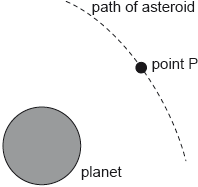| Date | May 2019 | Marks available | 2 | Reference code | 19M.2.HL.TZ2.9 |
| Level | Higher level | Paper | Paper 2 | Time zone | 2 |
| Command term | Show that | Question number | 9 | Adapted from | N/A |
Question
A planet of mass m is in a circular orbit around a star. The gravitational potential due to the star at the position of the planet is V.
Show that the total energy of the planet is given by the equation shown.
Suppose the star could contract to half its original radius without any loss of mass. Discuss the effect, if any, this has on the total energy of the planet.
The diagram shows some of the electric field lines for two fixed, charged particles X and Y.
The magnitude of the charge on X is and that on Y is . The distance between X and Y is 0.600 m. The distance between P and Y is 0.820 m.
At P the electric field is zero. Determine, to one significant figure, the ratio .
Markscheme
✔
comparison with ✔
«to give answer»
ALTERNATIVE 1
«at the position of the planet» the potential depends only on the mass of the star /does not depend on the radius of the star ✔
the potential will not change and so the energy will not change ✔
ALTERNATIVE 2
r / distance between the centres of the objects / orbital radius remains unchanged ✔
since , energy will not change ✔
✔
✔
Examiners report
This was generally well answered but with candidates sometimes getting in to trouble over negative signs but otherwise producing well-presented answers.
A large number of candidates thought that the total energy of the planet would change, mostly double.
The majority of candidates had an idea of the basic technique here but it was surprisingly common to see the squared missing from the expression for field strengths.


